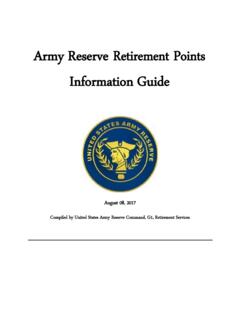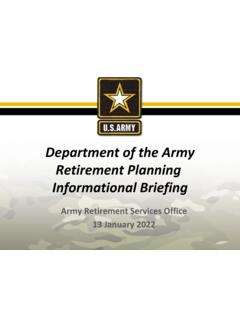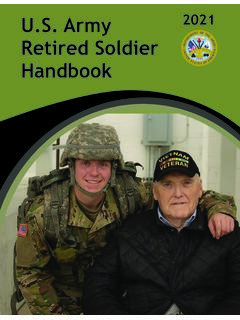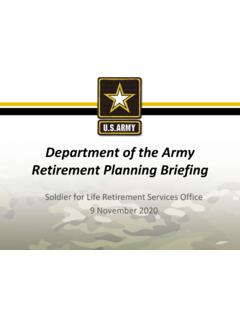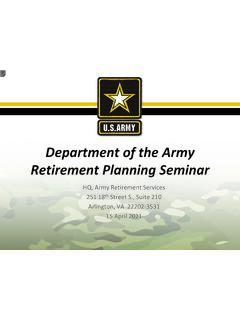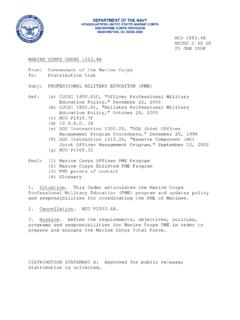Transcription of Army Reserve Retirement Points Information Guide
1 army Reserve Retirement Points Information Guide May 14, 2018 Compiled by United States army Reserve Command, G1, Retirement Services 2 Contents (Listed by paragraph number) Chapter 1 General Overview 1- 1, page 3 Retirement Points History1-2, page 3 Qualifying Years of Satisfactory Service 1-3, page 3 Anniversary Year End (AYE) Date 1- 4, page 4 Establishment and Adjustment to AYE 1- 5, page 4 Exceptions to Calculating AYE dates 1- 6, page 4 Credit for Partial Years of Service 1- 7, page 4 Eligibility for Retirement Point Credit for Non-Regular Retirement 1-8, page 5 Retirement Point Credit by Activity1-9, page 5 Reporting Points to Retirement Point Accounting System (RPAS)
2 1- 10, page 6 Chapter 2 Manual Input Manually Update Retirement Points 2-1, page 6 To Update Retirement Points manually 2-2, page 6 A VOID or BLANK DA Form 5016 2-3, page 7 Maintain Retirement Points Business Rules 4- 4, page 7 Chapter 3 Nonresident Courses army Correspondence Courses 3-1, page 8 Electronic Based Distributed Learning 3-2, page 9 Chapter 4 Points for Non-Paid Training Retirement Points Non-Paid Training DA Form 1380 (Record of Individual Performance of Reserve Duty Training) 4-1, page 9 Common errors with the DA Forms 1380 4- 2, pages 10 & 11 Chapter 5 Mobilization/Demobilization Mobilization/Demobilization 5- 1, page 12 Appendixes A-1.
3 References, page 13 B-1. Supporting Documents, page 14 B-2. army Human Resources Command Personnel Action Branches Point of Contacts page, 15 B-3. Other Services POCs for Retirement Points , page 16 C-1. Reporting Points to RPAS, page 17 3 Chapter 1 General 1- 1 Overview This Information Guide provides an overview and standard operating procedures for the Reserve Component Retirement Points Accounting System (RPAS); when, where, and how Human Resources (HR) Professionals to contact army Human Resources Command (AHRC) for assistance and input; when, where, and how to review Soldier Retirement point records; business rules on cases unit HR personnel should complete and those that require assistance from AHRC.
4 Documentation required and how to acquire it to support Retirement Points transactions and corrections. The Information Guide also includes Information on crediting and awarding of Retirement Points , establishment of the Anniversary Year End (AYE) date, proof of performance documents, eligibility for Retirement Points , and Retirement Points for non-paid training. Unit HR personnel with challenging cases should contact their Regional Personnel Action Center (RPAC), US army Reserve Command G -1, Service and Support Division or army Human Resources Command (AHRC), Personnel Action Branch (PAB).
5 Additional Information and guidance pertaining to Retirement Points is available on the army Reserve Command G -1 website at and the AHRC web site at: 1- 2 Retirement Points History a. When awarding Retirement Points a member is only entitled to a defined maximum of Individual Duty Training (IDT), Extension Course and Membership Points per year. However, RPAS will allow entrance of more Points and display them but it will not count in the total Points . Retirement Points credited for activities other than active service or Funeral Honors as defined as IDT and Membership Points may not exceed: (1) Prior to 23 Sep 1996: 60 point rule in effect (2) On or after 23 Sep 1996: 75 point rule in effect (3) On or after 30 Oct 2000: 90 point rule in effect (4) On or after 30 Oct 2007: 130 point rule in effect b.
6 All active duty training is credited. However, a Soldier can only receive credit for a maximum of 365 (366 in a leap year) Retirement Points in a year. 1- 3 Qualifying Years of Satisfactory Service A qualifying year of service for non-regular retired pay is when the Regular or Reserve Soldier is credited with a minimum of 50 Retirement Points . 4 1- 4 Anniversary Year End (AYE) Date AYE date determines the last day a Retirement point may be updated annually for a Soldier, so it is important to understand how it is established. The AYE date can only be changed by AHRC.
7 1- 5 Establishment and Adjustment to AYE The date to determine the AYE date is established by the date the Soldier entered into active service or into active status in a Reserve component. The date the Soldier enter the Active Reserve is their anniversary year beginning date. As long as the Soldier has no break-in-service, the Anniversary Year Ending date (AYE) will be one year later. a. For example, a Soldier who joins the army Reserves on 2 July would have an anniversary year beginning date of 2 July and an AYE of 1 July, one year later minus 1 day.
8 B. A break-in-service occurs only when a Soldier transfers to an inactive status list, the inactive National Guard, a temporary disability retired list, the Retired Reserve or is discharged to civilian life for longer than 24 hours. There will be no break-in-service if the Soldier transfers directly to another Regular or Reserve Component. When a Soldier with a break-in-service returns to an active Reserve status or to active service, the revised AYE start date shall be the date of return or reentry. 1- 6 Exceptions to Calculating AYE dates a.
9 In the case of Officers with Reserve service as a cadet or midshipmen at Service or in a Reserve Officers Training Corps program, the AYE start date is established by the date the Soldier entered into active service or active status, minus any service as a cadet or midshipman. b. In the case of enlisted Soldier (who served as a cadet or midshipman but who did not later receive or who do not hold a commission as an officer), service as a cadet or midshipman at a service academy shall be included and counted as active duty. You should be able to find this Information on the individual s contract.
10 1- 7 Credit for Partial Years of Service a. A Soldier who has a break-in-service that occurs during an AYE shall be credited with a partial year of qualifying service for non-regular Retirement . When, as a result of a break-in-service, a partial year occurs, the Soldier must meet the minimum Retirement point requirements for the Soldier s service to be credited as a partial year towards a qualifying year. A partial qualifying year is any period less than 12 full months in which the Retirement Points credited to a Soldier, when computed proportionally, are equal to or greater than 50 Points .
